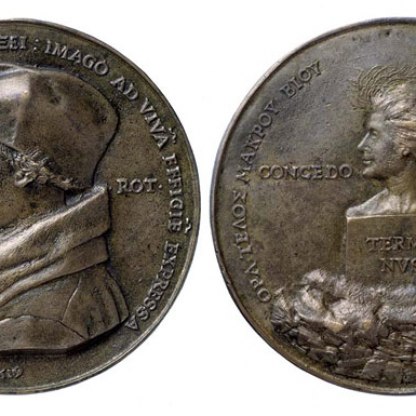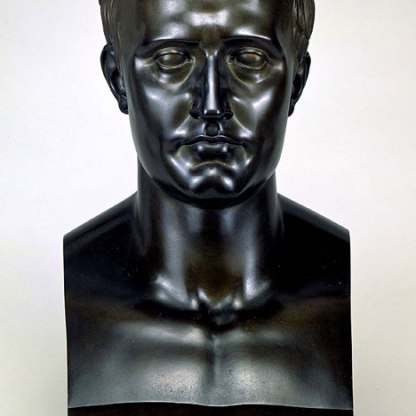A Bust of Albert Einstein

If you are out to describe the truth, leave elegance to the tailor.
When he reputedly said this, the great Austrian physicist Albert Einstein was referring to his own notorious scruffiness. The observation could apply just as well, however, to this portrait of him by his contemporary, Jacob Epstein. Rough and unpolished as it may be, the viewer is nevertheless persuaded that the subject is being presented in a truthful way.
Compared to Antoine Chaudet’s similar-sized head of Napoleon Bonaparte made in 1808 [M.1-1866], with its smooth, glossy finish and idealised features, Epstein’s work does indeed lack conventional elegance. There is none of the dignified distance between viewer and subject, none of the classical hauteur, that characterized so much portrait sculpture in the eighteenth and nineteenth centuries. Instead there is a strong and immediate sense of character, of psychological truth. Epstein said of his sitter, 'his glance contained a mixture of the humane, the humorous and the profound', and these are qualities superbly bought out in the bronze.
If one were unfamiliar with Einstein’s face, with his drooping eyelids, melancholy eyes, wild hair and unkempt moustache, one would not perhaps immediately identify him as an eminent scientist. His appearance contrasts sharply, for instance, with the bust of Sir Isaac Newton seen in the background of a portrait by William Hogarth from the late 1730s, left [648]. There the great mathematician looks out beyond the viewer, his serious brow and loose-fitting garments recalling the emperors of ancient Rome.
Epstein said of Einstein, 'he resembled the ageing Rembrandt', and looking at the great Dutch artist’s Self-Portrait Drawing at a Window, in the Fitzwilliam, left [AD.12.39-1], we can recognise the same likeable mixture of humility and deep intelligence, the same rather shabby charisma. There is also a striking similarity between this bronze and the image of Terminus on the reverse of a medal designed for the great Renaissance philosopher, Erasmus of Rotterdam [CM.28-1979].
Epstein’s sculpture is as affably informal as Albert Einstein himself is reputed to have been: genius has here been humanised. This is the Nobel Prize winner, the revered academic who, when asked to explain his ground-breaking theory of relativity, reportedly said:
Put your hand on a stove for a minute, and it seems like an hour. Sit with a pretty girl for an hour and it seems like a minute. That’s relativity.
But it is also the man who had, only a few months earlier, been forced to flee Berlin, where he had been Director of Theoretical Physics at the Kaiser Wilhelm Institute. Hitler had come to power in January 1933, the Nazis had condemned Einstein’s ‘Jewish physics,’ and he had left Germany in fear of his life, a bounty of 1000 guineas on his head. He eventually settled with a professorship at Princeton in America, but before leaving Europe he spent time in Norfolk at the invitation of the Conservative M.P. and ally of Winston Churchill, Commander Oliver Locker-Lampson. And at Roughton Heath near Cromer, on the North Sea coast, in a beach hut containing a piano, Einstein smoked his pipe and chatted as Epstein, a fellow Jew, modelled his head in clay. It has been suggested that the American-born sculptor was instrumental in persuading the scientist to speak out publicly against Hitler.
Epstein is said to have regretted not being able to work for longer on the sculpture before his subject left England. But one wonders how much more he would have really done. He was criticised in his lifetime for the unfinished look of his portrait bronzes, and what he said in his defence is eminently true of this work:
It is the rough surface which gives both character and likeness to the face ...
Themes and periods
Data from our collections database
Slightly over life-size, facing slightly right, head inclined a little forward. Bare-headed; hair is represented standing on end in an unruly way; moustache. Unfinished.
Bought from Messrs. A.Tooth & Sons, London by the donor
Legal notes
Given by Lady Jeans
Acquisition and important dates
- Method of acquisition: Given
- Dates: 1933-12
Dating
A total of six casts made - see letter in object's file from Epstein, (dated 15 July 1934). The other five are in: Tate, Science Museum (signed), Walker Art Gallery, Liverpool, Public Art Gallery, Huddersfield, Hebrew University, Jerusalem.
Albert Einstein (1879-1955), the brilliant theoretical physicist and Nobel Prize winner was staying at an army camp near Cromer, Norfolk, as a refugee, when he sat for this portrait in September 1933. This six hour modeling session took place in rather extraordinary surroundings - a room almost filled by a grand piano in a beach hut at Roughton Heath, near Cromer. Einstein was the guest of the journalist and MP, Commander Locker-Lampson, who had persuaded him to come to England from Belgium, where he had been living since Hitler came to power in Germany. Epstein stayed at the Royal Cromer Hotel, and for three days went to the hut for a two-hour sitting. Einstein smoked a pipe, and after the sitting played the piano or the violin. Epstein was immediately attracted to his sitter, who had flying hair, casual dress, and a glance which he described as humane, humorous and profound.
Although the portrait was modeled in just six hours and left incomplete, it is considered an excellent likeness, having captured Einstein’s humane, humorous and profound glance, and his ‘wild hair floating in the wind’. Epstein’s rugged execution gives it an informality which was equally characteristic of the sitter. Its rich impasto modeling recalls the work of Rembrandt, perhaps deliberately since Epstein believed that Einstein ‘resembled the ageing Rembrandt’.
See a letter in the object's file from Lady Jeans regarding its excellent likeness.
- 1930s
- 20th Century, second quarter
- George V
- Production date: AD 1933
Maker(s)
- Epstein, Jacob Sculptor
Note
A total of six casts made - see letter in object's file from Epstein, (dated 15 July 1934). The other five are in: Tate, Science Museum (signed), Walker Art Gallery, Liverpool, Public Art Gallery, Huddersfield, Hebrew University, Jerusalem.
Albert Einstein (1879-1955), the brilliant theoretical physicist and Nobel Prize winner was staying at an army camp near Cromer, Norfolk, as a refugee, when he sat for this portrait in September 1933. This six hour modeling session took place in rather extraordinary surroundings - a room almost filled by a grand piano in a beach hut at Roughton Heath, near Cromer. Einstein was the guest of the journalist and MP, Commander Locker-Lampson, who had persuaded him to come to England from Belgium, where he had been living since Hitler came to power in Germany. Epstein stayed at the Royal Cromer Hotel, and for three days went to the hut for a two-hour sitting. Einstein smoked a pipe, and after the sitting played the piano or the violin. Epstein was immediately attracted to his sitter, who had flying hair, casual dress, and a glance which he described as humane, humorous and profound.
Although the portrait was modeled in just six hours and left incomplete, it is considered an excellent likeness, having captured Einstein’s humane, humorous and profound glance, and his ‘wild hair floating in the wind’. Epstein’s rugged execution gives it an informality which was equally characteristic of the sitter. Its rich impasto modeling recalls the work of Rembrandt, perhaps deliberately since Epstein believed that Einstein ‘resembled the ageing Rembrandt’.
See a letter in the object's file from Lady Jeans regarding its excellent likeness.
Place(s) associated
- England
Materials used in production
Read more about this recordAudio description
Other highlight objects you might like
Suggested Curating Cambridge products
Sign up to our emails
Be the first to hear about our news, exhibitions, events and more…





